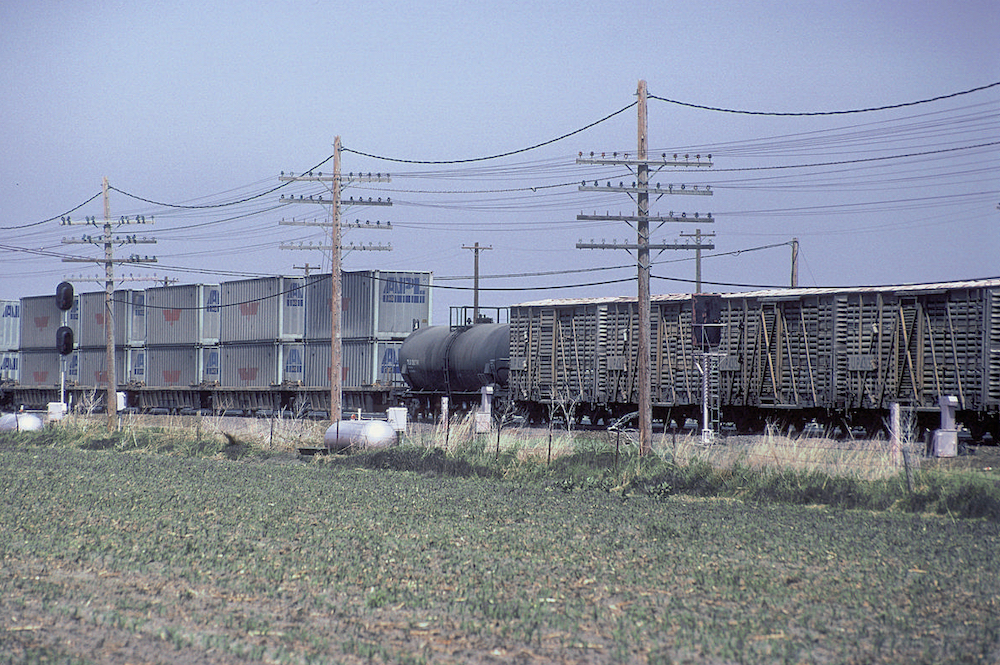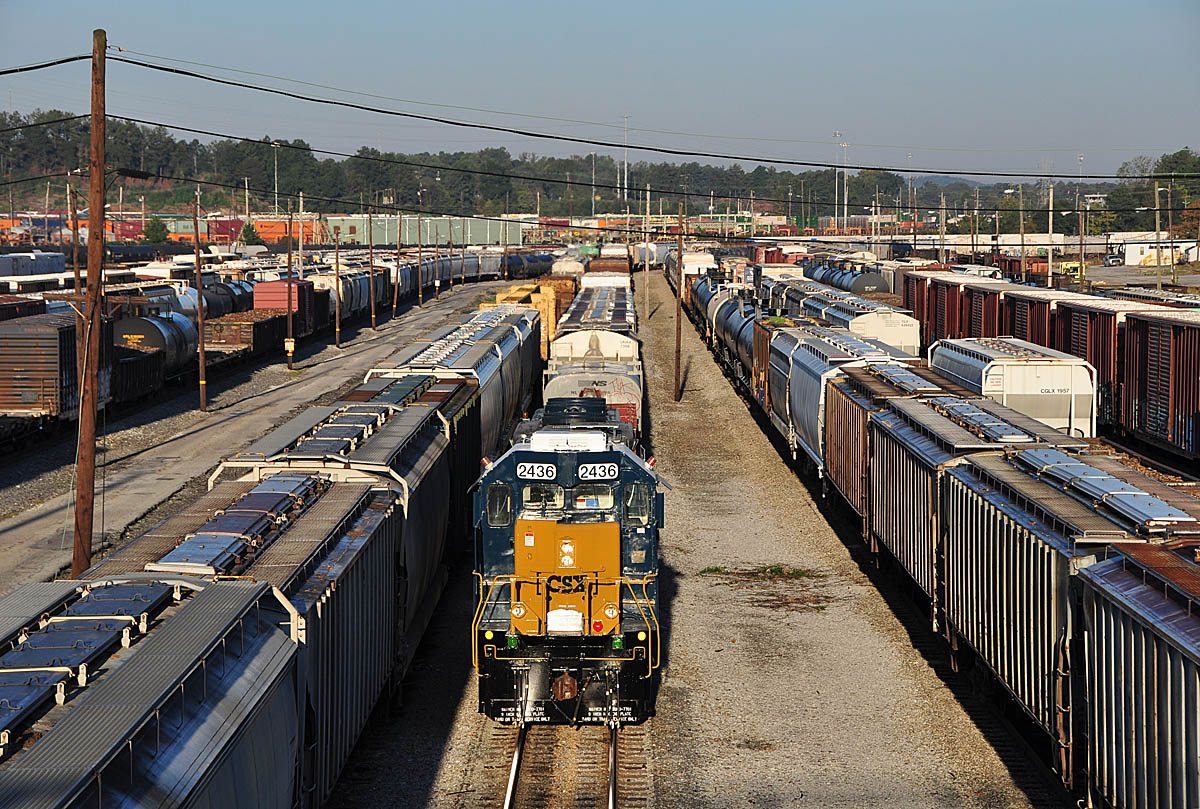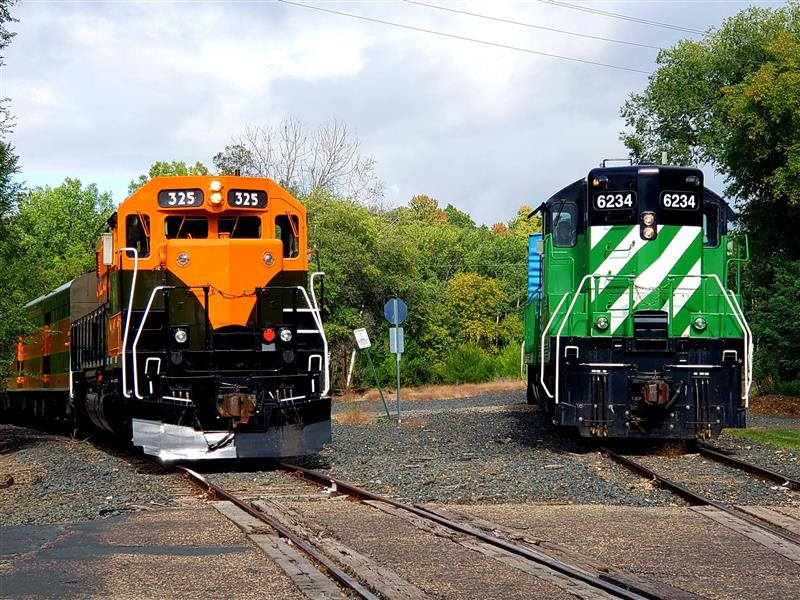
Modern day train operations are largely controlled by train dispatchers or control operators. A dispatcher directly controls all movements on a given piece of track, while a control operator typically handles movement on a smaller piece of trackage — operating under the direction of a dispatcher.
Control operators can typically be found at interlockings, or controlling a small piece of main line from a location other than where the dispatcher is located at. These individuals coordinate movement between trains and other individuals or equipment that have a need to be in the same general area simultaneously.
Let’s look at how this is done. It should be noted that this is a general overview of how trains are controlled. Three major standards for operating rules exist across the U.S. and Canada, covering the majority of railroads with rules and terminology varying between each of them.
The three main operating rules are:
- General Code of Operating Rules
- Northeast Operating Rules Advisory Committee
- Canadian Rail Operating Rules
Track is generally divided into two types: main track and other than main track. A number of documents and instructions identify this designation, depending on the railroad. One of the principal documents is the timetable (below). Published as needed and updated by other means as conditions change between publications, the timetable maps out the railroad listing stations, sidings, and other details of the railroad’s track. The timetable shows many things including tracks, the type of authority needed to occupy them, mileposts, and stations along the route.
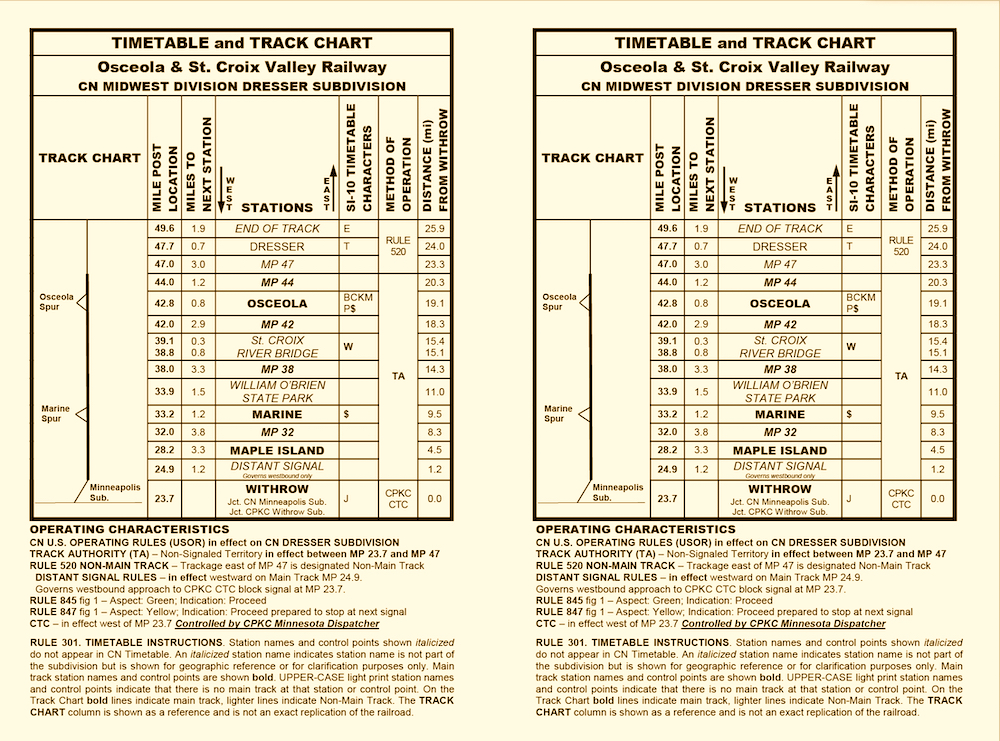
Other than main track
Normally, other than main track is not controlled by a dispatcher. Trains typically operate at a speed that allows them to stop within half the range of vision, watching out for hazards such as men, equipment, misaligned switches, and derails. There is no maximum speed limit, but operation is typically at lower speeds. Areas such as yards and industrial tracks are also not controlled by a dispatcher or control operator, with movement made as restricted speed. Operation at restricted speed is similar to other than main track, with a speed allowing the ability to stop within half the range of vision while looking out for hazards, but maximum speed is 20 mph or less.
Some yards have yardmasters who control movement; timetables or other publications provide details how to contact them. On the radio, you will hear trains call for the yardmaster as they approach the yard. If authorized by the yardmaster, the dispatcher will line the switch into the yard (if necessary) to allow movement off the main line.
On some railroads, yard limits will be established on the main track to allow movement of trains and equipment without permission to enter from the dispatcher or control operator. Signs will conspicuously show the beginning and end of these limits, and operating rules or other publications outline the steps necessary to occupy yard limits.
The dispatcher will have a separate radio channel(s) and dedicated phone number. To leave the yard and enter the main line, the train will contact the dispatcher via phone or radio and wait until authority is granted, either verbally or via a signal controlled by the dispatcher.
Main track operation
Dispatchers or control operators are designated in the timetable as well. Timetables list the dispatchers, their radio channels, and their phone numbers. Once a train contacts the dispatcher and gets authority to occupy the main line, the train may proceed.
Other methods of occupying the main track without dispatcher authorization are typically outlined in the operating rules or other publication. In general, how a dispatcher or control operator manages trains and other equipment depends on the method of operation for a given piece of track.
On a lower-density main, there are no signals and trains receive verbal authority to move between two points. This is typically called dark territory. The locations used for authority generally are mileposts, station signs, or block limit signs.
On a higher-density main line, signals create blocks to provide safe operating distances between trains. Authority is typically given in the same manner as dark territory, with the signal system allowing for closer train spacing. The most common is Centralized Traffic Control, in which certain signals and all switches are directly controlled by the dispatcher or control operator. Authority in CTC onto the main track can either be verbal or by a signal indication controlled by the dispatcher or control operator.
Railroad rule books show the meaning of each signal’s color, or aspect. This meaning, called the indication, can change from railroad to railroad. Generally, a green signal tells the engineer that the next two blocks ahead are clear. A yellow signal means that only the block ahead is clear, and to be prepared to stop at the next signal. A red signal means to stop before the end of the current block. Multiple signals on the same mast allow for more signal aspects and indications, informing engineers, for example, that they will be crossing from one track to another.
The dispatcher or control operator is helped by a computer to ensure trains cannot enter track that is already occupied by another train or approach a switch that is not properly lined. Track maintenance workers who want to work on a main track must also contact the dispatcher, who will give them permission to work on a designated section of track, along with a time limit during which they are protected from other movements. This process is generally the same for signaled and dark territory.
Track Authority
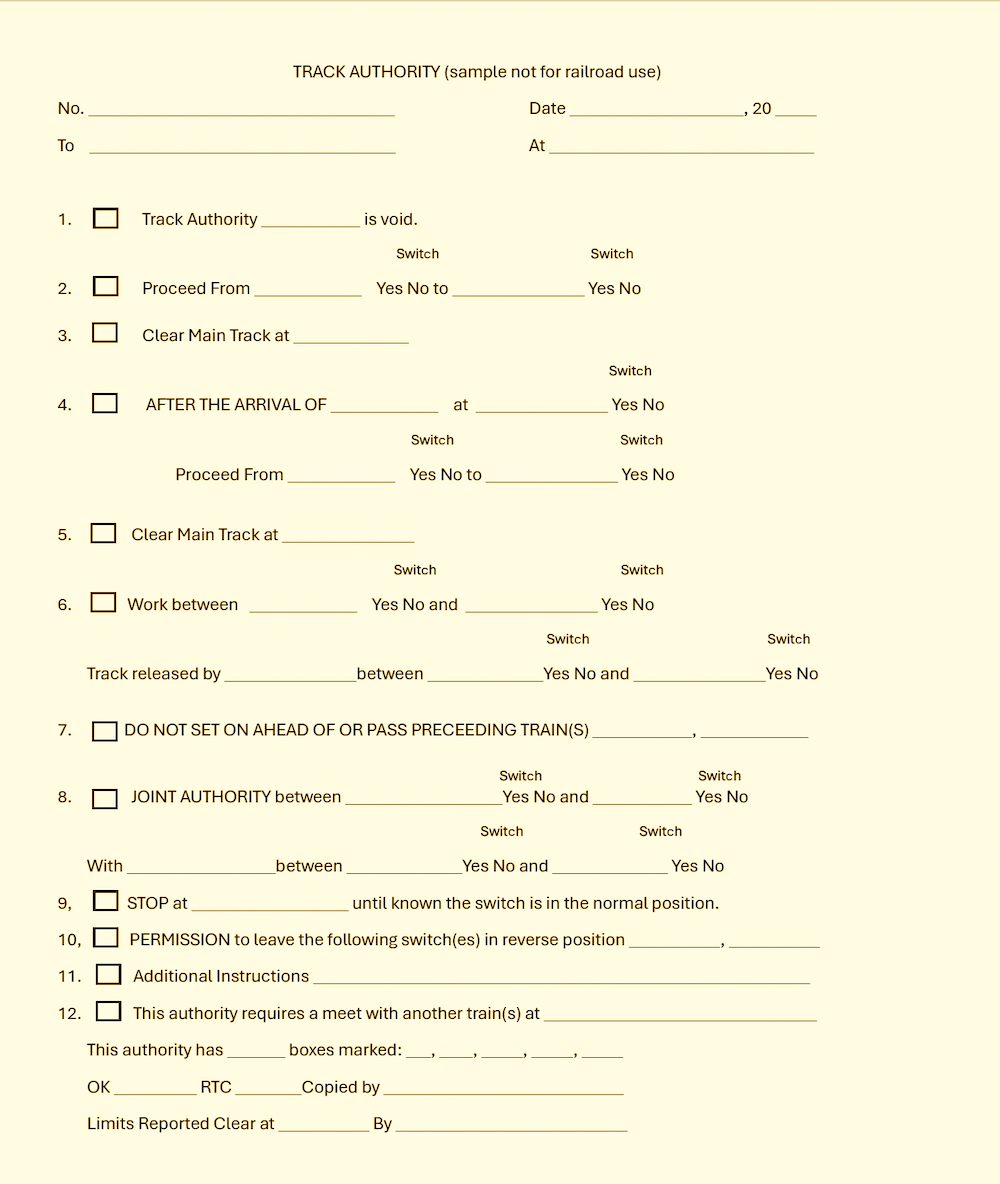
This Track Authority example, used under Canadian National’s U.S. Operating Rules, provides many options.
Most authority given is based on mile markers, station signs, or block limit signs. You can see on figure 2 that a Track Authority allows trains to share the same main track as “Joint Authority.” This is a way to have two or more trains on the same piece of track. If issued Joint Authority, the trains must communicate with each other and determine where it is safe for each train to be.
Normally this done via radio, but if the trains cannot communicate via radio the dispatcher can help coordinate the two trains.
But what if a track worker or inspector wishes to use the same track? Here the trains are coordinated by the track foreman. The foreman may be an inspector in a high rail vehicle or a work party maintaining the track. Railroads have a separate form for job sites, but it works much the same. A train gets permission from the foreman to move through a work area.
When issuing the Track Authority, the dispatcher enters the information in their computer and that piece of track is shown as occupied.
There are other documents controlling train operation: Railroad Rule Book, Bulletin, Special Orders, etc. All of these control operations can change from day to day. Bulletins and Special orders are used to show special conditions on the track.
Trains normally have daily bulletins as things change (speed limits change, grade crossings may not work …) and these must be checked with the dispatcher before getting Track Authorities and entering the main track.
Once the train in dark territory has completed its work and moved off the main track, the crew informs the dispatcher that their Track Authority is clear. The dispatcher acknowledges that and removes the train’s authority from their computer.
In our case, the Osceola & St. Croix Valley Railroad operates on the Withrow Subdivision. That main track runs from Withrow, Minn. (mile post 23.3) to the end of main track at mile post 47 at Dresser, Wis. Dresser was the junction for Soo Line trains headed to either Duluth, Minn., or Sault St. Marie, Mich. (the reason for the name Soo Line).
Each morning, the conductor calls the dispatcher for a Track Authority. The conductor identifies his train and verifies that he has the up-to-date bulletin order. The dispatcher reads the TA to the conductor and the conductor reads it back. If the read-back is correct, the dispatcher gives an “OK” time to enter at the bottom of the TA form. Once the OK is issued, the train can enter the main track and use the Dresser subdivision for our scenic runs.
We normally run trains back and forth from Marine, Minn., to Dresser, Wis. Our TA gives us a “Line 6” to work between mile post 32 (just west of Marine) to mile post 47 (end of main track in Dresser). This allows us to travel any direction between those two points (including beyond the end of main track into the Dresser Depot).
If we are also issued a “Line 8” (Joint Authority), another train or foreman can call to get permission to enter our limits. We then negotiate where each train/foreman will be and both operate on the same main track.
Typically, a track inspector will look over our subdivision a couple times a week and want to join us as they go from one end of the subdivision to the other. We work that out either face-to-face or over the radio and keep safely out of each other’s way. When joint operating, all trains are limited in speed (in our case 20 mph) and limited to speeds that allow us to stop in less than half the distance we can see (restricted speed). Once the train/foreman joining us completes their work, they report to us they are clear and we are no longer joint with them.
At the end of the day, we clear the main track, lock all the switches in the normal position (for main line movement) and report to the dispatcher we are clear and the switches returned to normal. After that our train no longer has authority to occupy the main track.
What will you hear on the railroad radios? You may hear:
- Trains copying and repeating Track Authorities.
- Trains contacting other trains in joint authority.
- Trains canceling their Track Authorities when their job is completed or leaving main track.
- Trains entering and leaving the main track.
- In the case of our subdivision, trains announce their motion at every mile post ending with a number 5.
- Trains contacting the dispatcher to get permission to enter a main track or yard.
- Work foremen giving trains permission to enter their work area. (Allows the train to pass a red flag and pass at a certain speed.)
- Train engineers talking to their crew as they uncouple or couple, align switches, and depart stations.
Radios are being supplanted by direct communication with the trains and maintenance of way equipment’s on-board computer system meaning you will hear less and less radio traffic as time goes on.
Train control is a well-choreographed operation led by a dispatcher or control operator to let trains and other equipment operate safely over the main track across the country.
Trains Correspondent Chris Guss has contributed to this article.








